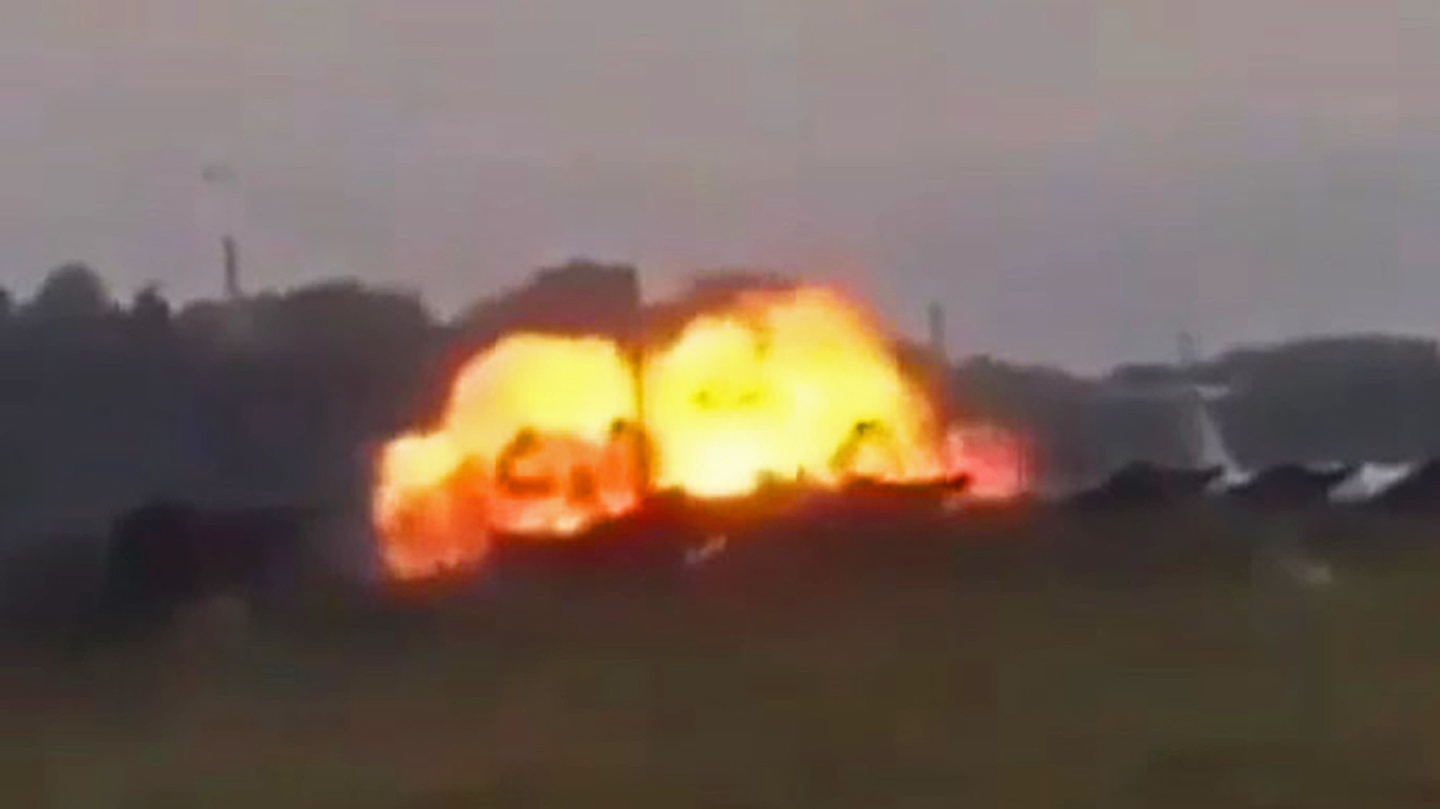While its incursion into Russian territory continues, Ukrainian forces are also maintaining their long-range offensive against Russian air bases, hammering three different airfields overnight. Based on available reports, the latest air bases to be targeted were Baltimor and Borisoglebsk in the Voronezh region, and Savasleyka in the Nizhny Novgorod region.
Multiple eyewitness accounts and videos posted to social media show the apparent strikes on at least three Russian air bases.
Most dramatically, footage purportedly of Savasleyka Air Base, hit by around 10 drones, according to Ukrainian reports, shows a drone’s fiery impact, seemingly close to the flight line (evidenced by the distinctive tail of an Il-76 Candid transport). The sound of gunfire can be heard, as the Russians try to defend the base from the incoming drones.
Another video, apparently taken in the vicinity of Savasleyka, seems to show a Lyutyi long-range one-way attack drone, a twin-boom type that is broadly similar in appearance to the Turkish-made Bayraktar TB2 and which has been used in other raids on targets deep within Russia.
Savasleyka is located around 400 miles from Ukraine.
NASA satellite data also shows signs of a fire at Savasleyka.
Savasleyka is a Long-Range Aviation base, with a primary offensive mission, using MiG-31 Foxhound interceptors adapted to carry the Kinzhal air-launched ballistic missile, a weapon that has seen sporadic use in the war in Ukraine.
Satellite imagery of the base from June shows MiG-31s with tires placed over their upper fuselages, a defensive measure that we have seen before on Russian long-range bombers and strike aircraft, the implications of which you can read more about here.
In a statement this morning, the Russian Ministry of Defense claimed that dozens of Ukrainian drones were shot down overnight, mainly across the southwest of the country. Russia says that drones were brought down in the regions of Belgorod, Bryansk, Kursk, Nizhny Novgorod, Orel, Rostov, Volgograd, and Voronezh.
The Russian Ministry of Defense claims to have shot down four missiles and no fewer than 117 Ukrainian drones during the raids.
Meanwhile, Baltimor in Voronezh is home to the 47th Composite Aviation Regiment (47 SAP) of the Russian Aerospace Forces (VKS), operating the Su-34 Fullback strike aircraft and the base is also home to the headquarters of the Air Force Academy and a maintenance unit. It is located around 110 miles from the front line.
Finally, Borisoglebsk is primarily a training base, specialized in preparing aircrews to operate tactical strike aircraft and ground-attack aircraft. It’s home to a pilot school that operates Su-25 Frogfoot attack aircraft and Yak-130 Mitten jet trainers. The airfield has also hosted detachments of Su-34s and Su-35S Flanker multirole fighters involved in operations against Ukraine.
Satellite imagery from Borisoglebsk, located roughly 210 miles from the front line, seems to show damage, if not outright the destruction of, two maintenance hangars at the base.
According to the Astra independent news site, which cites Russian military bloggers, eyewitnesses said that the air base at Borisoglebsk “caught fire” after a drone attack.
One prolific Russian military blogger, Fighterbomber, with close links to the VKS, wrote on Telegram that the overnight drone attacks were “Effective on some of [the targets]. Unfortunately, but legitimate.” Fightbomber added that these strategically important sites are covered only by “one or two Pantsir” short-range air defense systems.
While Ukraine’s attacks on Russian air bases and other key targets within Russian territory are not new, the latest raid is unusual in its scale.
According to CNN, a source from the Security Service of Ukraine (SBU) claims that the overnight attacks were the biggest of their kind to be launched against Russian airfields since the war began. That same source mentioned that another base, in the Kursk region, was also targeted.
As well as having to deal with long-range drone strikes, Russia is currently battling to blunt a Ukrainian advance into the Kursk region. Russia claims that its forces are now pushing back the Ukrainians, but there are conflicting reports about the success of this effort. For its part, Ukraine claims to now control at least 74 villages in the Kursk region.
Whatever the truth about the situation on the ground, the optics of the Ukrainian advance combined with the apparent continued vulnerability of Russian air bases to fend off drone attacks is particularly embarrassing for Russia.
Whether the latest strikes will presage a new, higher-intensity drone campaign against Russian airfields and other objectives, their timing could hardly be worse for Moscow.
Contact the author: thomas@thewarzone.com
